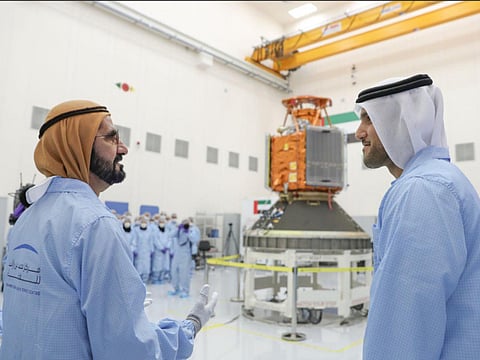KhalifaSat set for launch this year
Mohammad visits Mohammad Bin Rashid Space Centre to inspect progress of project to be completely built by Emirati engineers

Dubai: KhalifaSat, the first satellite to be completely built by Emirati engineers, is set to be launched later this year following a series of rigorous tests, it was announced on Saturday.
The announcement follows a visit by His Highness Shaikh Mohammad Bin Rashid Al Maktoum, Vice-President and Prime Minister of the UAE and Ruler of Dubai, to the Mohammad Bin Rashid Space Centre (MBRSC) to inspect the progress of the KhalifaSat project.
Once in earth’s orbit, KhalifaSat will provide detailed, high-quality images of earth for a variety of uses, such as environmental monitoring and urban planning, allowing the UAE to provide competitive services across the world.
“Emirati engineers are the first in the Arab world to construct a satellite without foreign assistance. This is a major achievement that signifies the high level of capabilities UAE youth have acquired in space technologies,” Shaikh Mohammad said.
“The high level of expertise that Emirati scientists and engineers have developed creates a strong foundation for the future scientific and technological development of the UAE,” he added.
“We are confident that the nation’s space industry sector will continue its strong growth, and emerge as a key component of our economy. The development of KhalifaSat is not only a source of pride for Emiratis and Arabs, but also a global achievement that will benefit humanity, and offers scientific solutions for development globally.”
At MBRSC, Shaikh Mohammad was welcomed by Hamad Obaid Al Mansouri, chairman of MBRSC; Major-General Talal Hamid Bel Houl Al Falasi; and Yousuf Al Shaibani, director-general of MBRSC, along with a number of senior executives of the space centre.
On Saturday, Shaikh Hamdan Bin Mohammad Bin Rashid Al Maktoum, Crown Prince of Dubai, posted a picture of Shaikh Mohammad’s visit on his Twitter account. The picture shows Shaikh Mohammad surrounded by Emirati scientists and engineers taking a selfie together.
“This picture tells a thousand stories ... The women story in UAE ... the youth empowerment ... the scientific achievements of our country ... the happiness in their eyes ... the leadership of HH ... the fatherly look in his eyes ... the future of uae ... all in one picture,” Shaikh Hamdan tweeted.
Shaikh Mohammad toured the centre and was briefed about the advanced features of KhalifaSat, which include an enhanced digital camera, satellite positioning system, faster download and communication, automatic satellite control system, and advanced target positioning system.
KhalifaSat is the first satellite to be developed in space technology laboratories in the UAE entirely by Emirati engineers. It is the third satellite owned by MBRSC following the launch of Dubai-1 and Dubai-2.
Once the manufacture and rigorous testing phases have been completed, the satellite will be transported to Japan for launch aboard the Mitsubishi Heavy Industries rocket, called H-IIA.
When placed into a Low Earth Orbit of approximately 613km, the satellite will proceed to capture detailed imagery capable of competing with the highest industry standards. The images beamed back to earth by KhalifaSat will be among the most detailed commercially available, with a Ground Sample Distance (GSD) of 0.7m Panchromatic, and 2.98m GSD in four multispectral bands.
The KhalifaSat project, launched by Shaikh Mohammad in 2013, is part of MBRSC’s long-term strategy to encourage innovation, stimulate technological progress, promote sustainable development and create a generation of Emirati scientists and engineers who will contribute to a scientific renaissance and lead ambitious space projects over the next decade.
Mars mission
The value of existing UAE space-related investments is more than Dh20 billion currently.
In 2020, the UAE plans to launch Hope, a probe that will explore Mars atmosphere as part of the Emirates Mars Mission, led by Emiratis. The historic event will mark the first Arab mission to another planet. The mission will be executed by the UAE Space Agency with support from international partners.
According to the mission’s website, the probe will take nine months to make the journey to Mars, making the UAE to be one of only nine countries with ambitions for Mars. The mission is scheduled to arrive in 2021 to coincide with the 50th anniversary of the establishment of the UAE.
The country’s investments in the space sector includes the satellite data and TV broadcast company Al Yah Satellite Communications, mobile satellite communication company Thuraya Satellite Telecommunications, and earth mapping and observation system DubaiSat.
In earth’s orbit, the UAE has already launched four spacecraft: DubaiSat-1 and DubaiSat-2 (imaging satellites) and Yahsat Y1A and Yahsat Y1B (communication satellites).
KhalifaSat
First satellite built by Emirati engineers in the UAE
To be launched this year
Will be launched aboard the Mitsubishi Heavy Industries rocket, H-IIA
To be sent into orbit from Tanegashima Space Centre on Tanegashima Island, Japan
When placed into low earth orbit (about 613km), satellite will capture detailed imagery of earth, for variety of uses such as environmental monitoring and urban planning
It will have a planned mission life of five years
The spacecraft weights 330kg
Sign up for the Daily Briefing
Get the latest news and updates straight to your inbox



